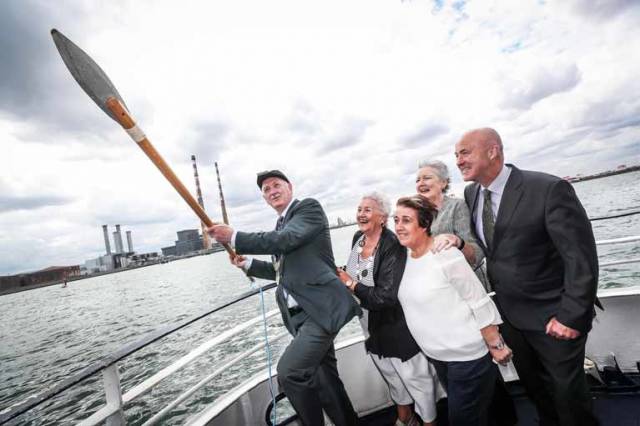The new Lord Mayor of Dublin, Nial Ring, yesterday took to the waters of Dublin Bay to take part in the annual ‘Casting of the Spear’ ceremony.
The ‘Casting of the Spear’ is a tradition dating back 530 years and the first official duty for Lord Mayor Nial Ring as Honorary Admiral of Dublin Port at his investiture from Dublin Port Chairperson Lucy McCaffrey. The title of Honorary Admiral of Dublin Port has been bestowed on the Lord Mayor of Dublin for over 20 years.
Historical records show that the maritime tradition of the Casting the Spear dates back to 1488 when Thomas Mayler, who was then Lord Mayor of Dublin, rode out on horseback and cast a spear as far as he could into the sea - this was to mark the city’s boundaries eastwards. Centuries later, the re-enactment ceremony reminds us of Dublin’s role as a port city in medieval times and highlights Dublin Port’s remarkable history since its establishment as a trading post some 1,200 years ago.
Newly invested Honorary Admiral of Dublin Port Nial Ring said; "As someone who was born and reared beside Dublin Port, I am absolutely thrilled to have the honour of ‘Casting the Spear’ and marking the eastern boundary of the City. Also, having the distinction of becoming the Honorary Admiral of the Port is also very exciting and I'm delighted to assume this prestigious role. The year ahead is a particularly busy and active for Dublin Port as it continues to develop, expand and grow and I will be working closely with Dublin Port Company CEO Eamonn O'Reilly and his team to progress its projects under the Masterplan.”
There to witness the Casting of the Spear ceremony were members of the local port community enjoying the launch of the annual South Docks Festival. The South Docks Festival is run by the St. Andrew’s Resource Centre of Pearse Street in collaboration with a number of local clubs and groups, including Pearse Area Recreational Centre. It is a celebration of community and heritage, taking pride in the identity inherent in the South Dublin Docklands area. The festival began on Friday 13th July and will run until Friday 20th July with activities, fun and games for all.
Dublin Port Chairperson Lucy McCaffrey commented at the ceremony; “I would like to thank Lord Mayor Ring for his participation in the Casting of the Spear, a ceremony that celebrates our heritage as a port city. Looking back to the origins of the ceremony, now more 500 years ago, it is extraordinary to think that our city’s boundaries were established by Thomas Mayler’s spear in the waters of medieval Dublin. Today’s re-enactment is symbolic of Dublin Port’s continued commitment to preserving, for the city and its people, an understanding of the history that binds the port and the city.”
“It is great to celebrate the South Docks Festival, which brings together the communities of our docks and our nearest neighbours. I would like to congratulate the organisers of the festival on a tremendous programme of events and to encourage everyone to come along and enjoy the festivities.”































































